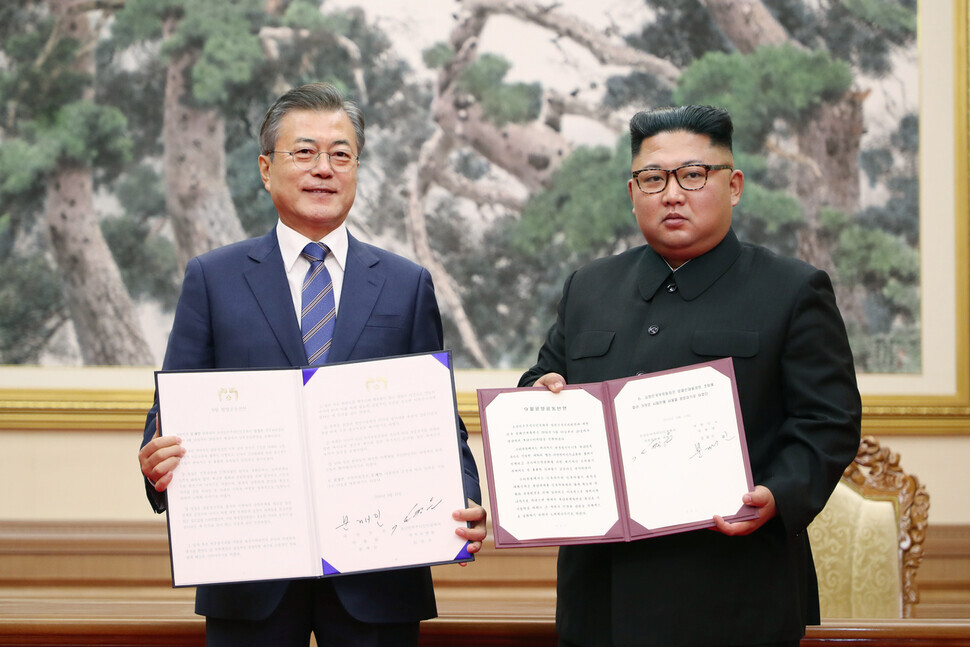hankyoreh
Links to other country sites 다른 나라 사이트 링크
[Editorial] 2 years after the Pyongyang Joint Statement, Seoul still needs to take bold action on inter-Korean relations

Inter-Korean relations, which had been proceeding so smoothly, began to falter after the rupture between North Korea and the US in their Hanoi summit in February 2019. The situation gradually deteriorated until inter-Korean relations were brought to a complete standstill with North Korea’s demolition of the Inter-Korean Liaison Office in Kaesong this past June.
“The reason the agreement has not been quickly implemented is because of our failure to overcome restrictions, some internal and some external,” South Korean President Moon Jae-in posted on his Facebook page on Sept. 19, marking the agreement’s second anniversary.
The restrictions mentioned by Moon would presumably include inter-Korean relations’ subordination to North Korea-US relations. It’s obvious that the issue of the denuclearization of the Korean Peninsula must be addressed by making progress on North Korea-US relations. But we can’t help but wonder what would have happened if the South Korean government had boldly and aggressively pursued measures to overcome external restrictions over the past two years, instead of simply waiting for progress in North Korea-US relations.
Acknowledging that inter-Korean relations are on pause does not mean agreeing with the statement released by the People Power Party on Sept. 19, which described the Pyongyang Joint Declaration as a “peace charade.” Despite several crises, South and North Korea have generally done a good job of observing the Comprehensive Military Agreement (CMA), which was concluded as an annex to the Pyongyang Joint Declaration. When we recall the security crisis in 2017, when rumors of war were rife on the Korean Peninsula, the absence of any armed clashes between South and North Korea on land, air, or sea over the past two years is an important accomplishment. This was the first time since the division of the Korean Peninsula that the two sides agreed upon and implemented an initial, but proactive, policy of arms control with the goal of precluding unintended military clashes and easing military tensions.
In order to get this stopped clock running again, the South Korean government needs to be bolder about taking creative and proactive measures. Since attention will turn to the upcoming presidential election campaign in the second half of next year, Moon doesn’t have much time left to take the lead in improving inter-Korean relations. The US is currently focused on the presidential election coming up in November, while North Korea is concentrating on containing the COVID-19 epidemic and responding to flood damage. What that means is that neither country can afford to pay attention to external affairs. It’s quite likely that both North Korea-US relations and inter-Korean relations will be left to drift for some time.
During a keynote address that Moon is scheduled to deliver over video in the 75th session of the UN General Assembly, on Sept. 23, he is reportedly planning to call upon the international community to take interest in and show support for the South Korean government’s efforts to achieve peace on the Korean Peninsula and in Northeast Asia. We hope this keynote address will serve as an opportunity to bring about a thaw in inter-Korean relations.
Please direct comments or questions to [english@hani.co.kr]

Editorial・opinion
![[Column] Park Geun-hye déjà vu in Yoon Suk-yeol [Column] Park Geun-hye déjà vu in Yoon Suk-yeol](https://flexible.img.hani.co.kr/flexible/normal/500/300/imgdb/original/2024/0424/651713945113788.jpg) [Column] Park Geun-hye déjà vu in Yoon Suk-yeol
[Column] Park Geun-hye déjà vu in Yoon Suk-yeol![[Editorial] New weight of N. Korea’s nuclear threats makes dialogue all the more urgent [Editorial] New weight of N. Korea’s nuclear threats makes dialogue all the more urgent](https://flexible.img.hani.co.kr/flexible/normal/500/300/imgdb/original/2024/0424/7317139454662664.jpg) [Editorial] New weight of N. Korea’s nuclear threats makes dialogue all the more urgent
[Editorial] New weight of N. Korea’s nuclear threats makes dialogue all the more urgent- [Guest essay] The real reason Korea’s new right wants to dub Rhee a founding father
- [Column] ‘Choson’: Is it time we start referring to N. Korea in its own terms?
- [Editorial] Japan’s rewriting of history with Korea has gone too far
- [Column] The president’s questionable capacity for dialogue
- [Column] Are chaebol firms just pizza pies for families to divvy up as they please?
- [Column] Has Korea, too, crossed the Rubicon on China?
- [Correspondent’s column] In Japan’s alliance with US, echoes of its past alliances with UK
- [Editorial] Does Yoon think the Korean public is wrong?
Most viewed articles
- 1[Column] Park Geun-hye déjà vu in Yoon Suk-yeol
- 2Thursday to mark start of resignations by senior doctors amid standoff with government
- 3Will NewJeans end up collateral damage in internal feud at K-pop juggernaut Hybe?
- 4[Guest essay] The real reason Korea’s new right wants to dub Rhee a founding father
- 5Why Korea shouldn’t welcome Japan’s newly beefed up defense cooperation with US
- 6[Editorial] New weight of N. Korea’s nuclear threats makes dialogue all the more urgent
- 7Kim Jong-un expressed ‘satisfaction’ with nuclear counterstrike drill directed at South
- 8[Column] ‘Choson’: Is it time we start referring to N. Korea in its own terms?
- 9N. Korean hackers breached 10 defense contractors in South for months, police say
- 10‘We must say no’: Seoul defense chief on Korean, USFK involvement in hypothetical Taiwan crisis